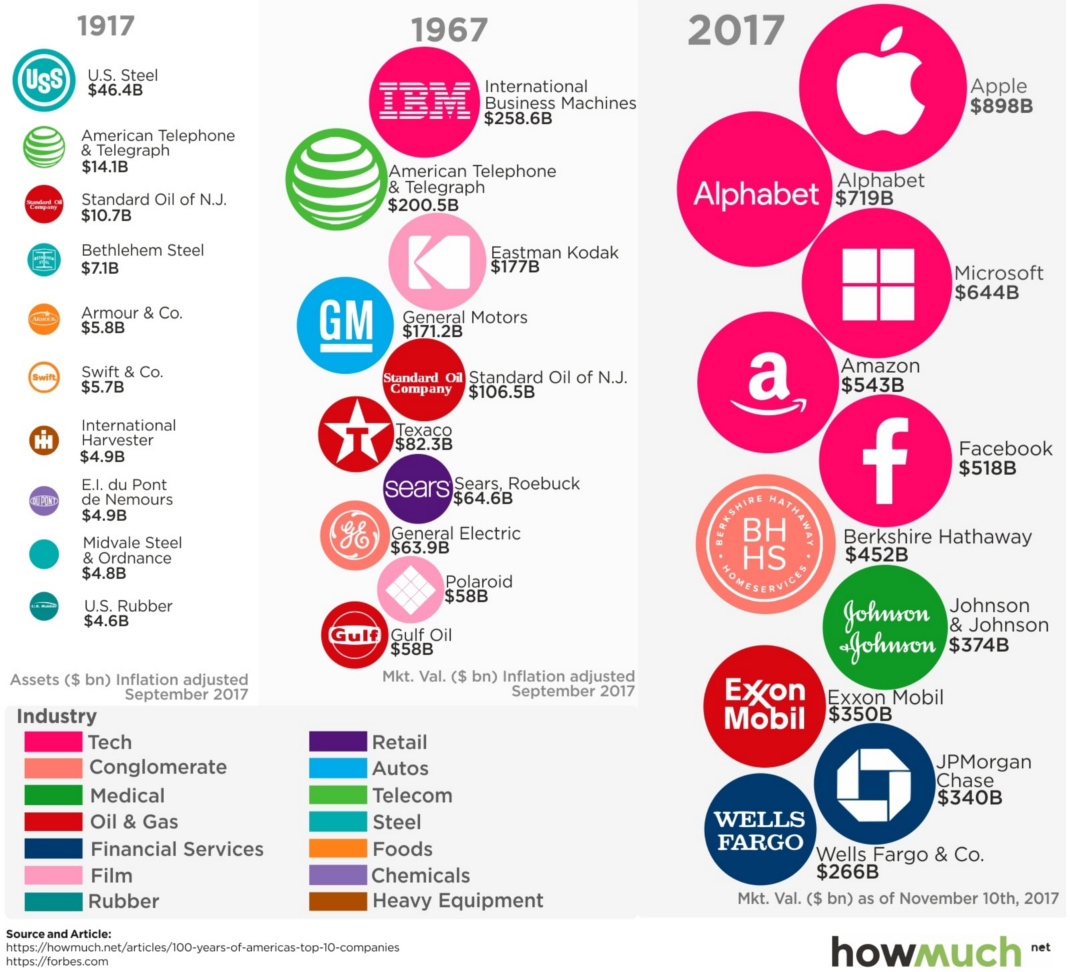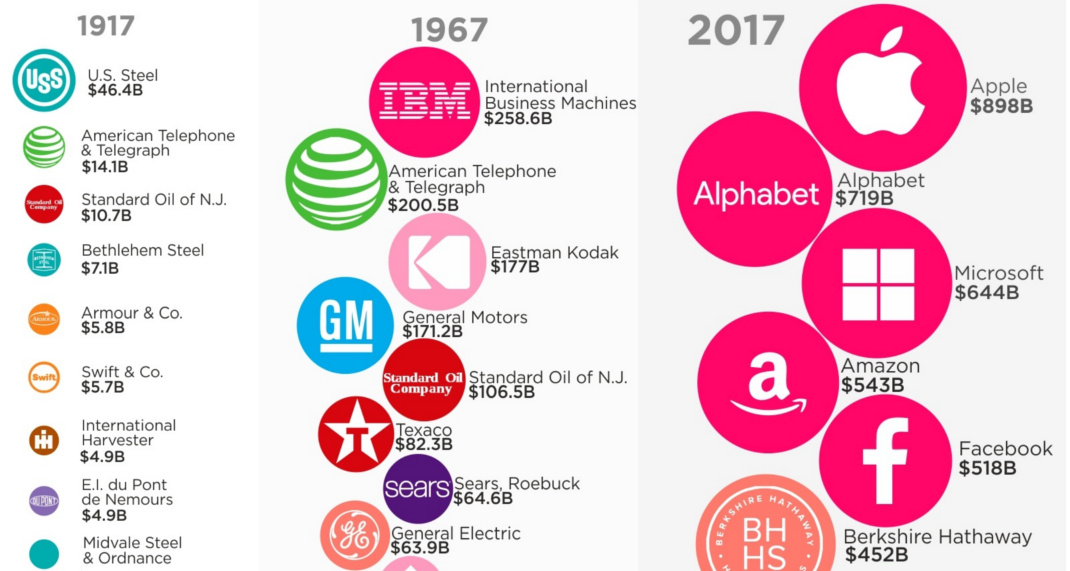Technology
Most Valuable U.S. Companies Over 100 Years

The Most Valuable Companies in America Over 100 Years
How much does the business world shift in a century?
Today’s visualization comes from HowMuch.net, and it uses Forbes data to show how the list of the top 10 companies in the U.S. has evolved over the last 100 years.
1917: The Industrialist Era
In 1911, both John D. Rockefeller’s Standard Oil and J.P. Morgan’s U.S. Steel (which was formed from Andrew Carnegie’s steel company and others) were facing antitrust action.
Standard Oil, which controlled over 90% of all oil in the United States by 1900, got split up into 34 independent companies after a ruling by the Supreme Court. However, U.S. Steel, which controlled 67% of steel in the country, was able to weather the antitrust storm at the time.
In the chart showing data for 1917, you can see that U.S. Steel – which was considered the world’s first “billion dollar” company – reigned supreme in the U.S. based on the value of its assets. Meanwhile, Standard Oil of N.J. (a fragment of the Standard Oil breakup) was still able to finish in the third spot on the list.
1967: The Hardware Era
Fast forward 50 years, and oil is still big.
Standard Oil of N.J. (eventually to be re-named as Exxon Corp. in 1972) is the fifth biggest company in the country. Texaco and Gulf Oil, both of which later merged into Chevron (another Standard Oil offshoot) also make the top 10 in terms of market valuation.
Aside from energy, the 1967 list seems dominated by companies that make tangible things. IBM was making some of the first and most advanced computers, GM was the largest U.S. auto manufacturer, and both Kodak and Polaroid made cameras. General Electric, a conglomerate, made everything from computers to jet engines at this time.
2017: The Platform Era
Fast forward to now, and platforms like Facebook, Amazon, Google, Microsoft, and Apple have taken over.
We’ve shown how these five companies make their billions, and also how Facebook and Google are able to dominate global ad revenues through scale.
Meanwhile, many of the stalwarts from 1967 have fallen: Polaroid and Kodak both filed for bankruptcy, and Sears Canada filed for bankruptcy months ago. And of the big names from 1917, only AT&T remains of significance.
This raises the question: what will the next 50 years hold – and how many names from the 2017 list will remain?
Technology
Visualizing AI Patents by Country
See which countries have been granted the most AI patents each year, from 2012 to 2022.

Visualizing AI Patents by Country
This was originally posted on our Voronoi app. Download the app for free on iOS or Android and discover incredible data-driven charts from a variety of trusted sources.
This infographic shows the number of AI-related patents granted each year from 2010 to 2022 (latest data available). These figures come from the Center for Security and Emerging Technology (CSET), accessed via Stanford University’s 2024 AI Index Report.
From this data, we can see that China first overtook the U.S. in 2013. Since then, the country has seen enormous growth in the number of AI patents granted each year.
| Year | China | EU and UK | U.S. | RoW | Global Total |
|---|---|---|---|---|---|
| 2010 | 307 | 137 | 984 | 571 | 1,999 |
| 2011 | 516 | 129 | 980 | 581 | 2,206 |
| 2012 | 926 | 112 | 950 | 660 | 2,648 |
| 2013 | 1,035 | 91 | 970 | 627 | 2,723 |
| 2014 | 1,278 | 97 | 1,078 | 667 | 3,120 |
| 2015 | 1,721 | 110 | 1,135 | 539 | 3,505 |
| 2016 | 1,621 | 128 | 1,298 | 714 | 3,761 |
| 2017 | 2,428 | 144 | 1,489 | 1,075 | 5,136 |
| 2018 | 4,741 | 155 | 1,674 | 1,574 | 8,144 |
| 2019 | 9,530 | 322 | 3,211 | 2,720 | 15,783 |
| 2020 | 13,071 | 406 | 5,441 | 4,455 | 23,373 |
| 2021 | 21,907 | 623 | 8,219 | 7,519 | 38,268 |
| 2022 | 35,315 | 1,173 | 12,077 | 13,699 | 62,264 |
In 2022, China was granted more patents than every other country combined.
While this suggests that the country is very active in researching the field of artificial intelligence, it doesn’t necessarily mean that China is the farthest in terms of capability.
Key Facts About AI Patents
According to CSET, AI patents relate to mathematical relationships and algorithms, which are considered abstract ideas under patent law. They can also have different meaning, depending on where they are filed.
In the U.S., AI patenting is concentrated amongst large companies including IBM, Microsoft, and Google. On the other hand, AI patenting in China is more distributed across government organizations, universities, and tech firms (e.g. Tencent).
In terms of focus area, China’s patents are typically related to computer vision, a field of AI that enables computers and systems to interpret visual data and inputs. Meanwhile America’s efforts are more evenly distributed across research fields.
Learn More About AI From Visual Capitalist
If you want to see more data visualizations on artificial intelligence, check out this graphic that shows which job departments will be impacted by AI the most.
-

 Mining1 week ago
Mining1 week agoGold vs. S&P 500: Which Has Grown More Over Five Years?
-

 Markets2 weeks ago
Markets2 weeks agoRanked: The Most Valuable Housing Markets in America
-

 Money2 weeks ago
Money2 weeks agoWhich States Have the Highest Minimum Wage in America?
-

 AI2 weeks ago
AI2 weeks agoRanked: Semiconductor Companies by Industry Revenue Share
-

 Markets2 weeks ago
Markets2 weeks agoRanked: The World’s Top Flight Routes, by Revenue
-

 Demographics2 weeks ago
Demographics2 weeks agoPopulation Projections: The World’s 6 Largest Countries in 2075
-

 Markets2 weeks ago
Markets2 weeks agoThe Top 10 States by Real GDP Growth in 2023
-

 Demographics2 weeks ago
Demographics2 weeks agoThe Smallest Gender Wage Gaps in OECD Countries










